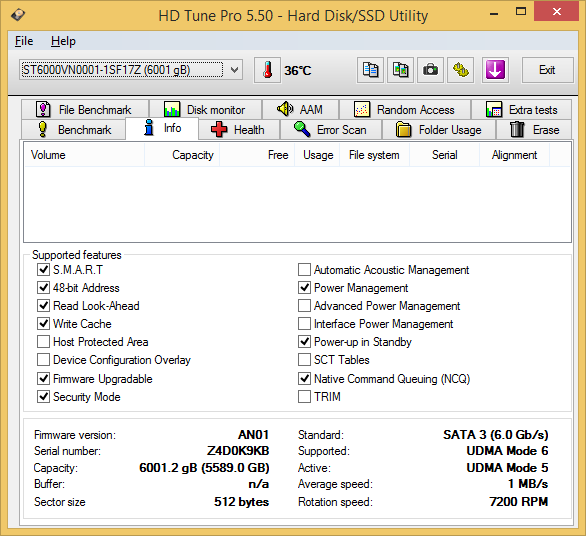Seagate Enterprise NAS HDD 6 TB Review
by Ganesh T S on December 10, 2014 8:00 AM EST- Posted in
- NAS
- Storage
- Seagate
- HDDs
- Enterprise
Specifications and Feature Set Comparison
Prior to getting into the performance evaluation, we will take a look at the specifications of the 6 TB Seagate Enterprise NAS HDD and see how it compares against the other NAS-specific hard drives that we have looked at before. As mentioned in our launch coverage, the Enterprise NAS HDD takes the hardware guts from the Enterprise Capacity v4 drives and firmware features from the NAS HDD line. The hardware aspects (such as the rotational speed, cache size, URE ratings etc.) come from the Enterprise Capacity v4. The table below presents the data for the drive against the others in our evaluation database.
| Comparative HDD Specifications | ||
| Aspect | ||
| Model Number | ST6000VN001 | ST6000VN001 |
| Interface | SATA 6 Gbps | SATA 6 Gbps |
| Sector Size / AF | 512E | 512E |
| Rotational Speed | 7200 RPM | 7200 RPM |
| Cache | 128 MB | 128 MB |
| Rated Load / Unload Cycles | 600 K | 600 K |
| Non-Recoverable Read Errors / Bits Read | < 1 in 1015 | < 1 in 1015 |
| MTBF | 1.2 M | 1.2 M |
| Rated Workload | 180 TB/yr | 180 TB/yr |
| Operating Temperature Range | 5 to 60 C | 5 to 60 C |
| Acoustics (Seek Average - dBA) | 27 dBA | 27 dBA |
| Physical Parameters | 14.7 x 10.19 x 2.61 cm; 780 g | 14.7 x 10.19 x 2.61 cm; 780 g |
| Warranty | 5 years | 5 years |
| Price (in USD, as-on-date) | $TBD | $TBD |
A high level overview of the various supported SATA features is provided by HD Tune Pro.

We get a better idea of the supported features using FinalWire's AIDA64 system report. The table below summarizes the extra information generated by AIDA64 (that is not already provided by HD Tune Pro).
| Comparative HDD Features | ||
| Aspect | ||
| DMA Setup Auto-Activate | Supported; Disabled | Supported; Disabled |
| Extended Power Conditions | Supported, Enabled | Supported, Enabled |
| Free-Fall Control | Not Supported | Not Supported |
| General Purpose Logging | Supported; Enabled | Supported; Enabled |
| In-Order Data Delivery | Not Supported | Not Supported |
| NCQ Priority Information | Not Supported | Not Supported |
| Phy Event Counters | Supported | Supported |
| Release Interrupt | Not Supported | Not Supported |
| Sense Data Reporting | Supported, Disabled | Supported, Disabled |
| Software Settings Preservation | Supported; Enabled | Supported; Enabled |
| Streaming | Not Supported | Not Supported |
| Tagged Command Queuing | Not Supported | Not Supported |










51 Comments
View All Comments
cm2187 - Wednesday, December 10, 2014 - link
+1MikeMurphy - Wednesday, December 10, 2014 - link
Exactly.tocker - Wednesday, December 10, 2014 - link
We could place bets. I'm going for a 40% failure rate inside of 3 years.Thats probably being generous.
Laststop311 - Thursday, December 11, 2014 - link
https://www.backblaze.com/blog/hard-drive-reliabil...Hitachi has the lowest failure rate in a massively huge deployment of HDD's in a cloud storage facility. Gives you a pretty good idea just how amazing they are.
ddriver - Sunday, December 14, 2014 - link
Yeah, but that's not a given, remember back in the days where those same deskstar disks were called deathstar cuz they were dropping down life flies?It would be nice of more cloud storage provides post their stats so that regular people know what to buy.
Zap - Wednesday, December 10, 2014 - link
What RPM are these drives? I know manufacturers like to obfuscate this information, but as a consumer I'd like to know.wavetrex - Wednesday, December 10, 2014 - link
That raw read/write speed is typical for 1TB platters on a 7200rpm drive.My guess is that speed is the comfort zone for these drives, and they probably spin down to 5400 when idling to reduce power consumption
MrSpadge - Wednesday, December 10, 2014 - link
No matter what WD likes to tell you with "IntelliPower" etc. drives do not normally run at different speeds. The mechanics, head aerodynamics / fly height and everything must be tailored to a specific spindle speed. Changing it on the fly has so far been unfeasible and wouldn't be much quicker than simply spinning down at idle, yet provide a only a small fraction of the power savings.hlmcompany - Wednesday, December 10, 2014 - link
IntelliPower and WD don't say that the drive changes speed during operation. An IntelliPower drive is a fixed speed, but set to meet certain power requirements. Because of this not all IntelliPower drives are at the same spindle speed.http://wdc.custhelp.com/app/answers/detail/a_id/36...
Navvie - Wednesday, December 10, 2014 - link
When 'IntelliPower' was first introduced WD were very secretive about exactly what it meant. Although there are now sources, their vague comments on exactly what IntelliPower is lead people to the conclusion that the drives were adjusting speed depending on demand.I believe the clever guys at SPCR were the first to determine the speed of IntelliPower drives by looking at the drives harmonics.